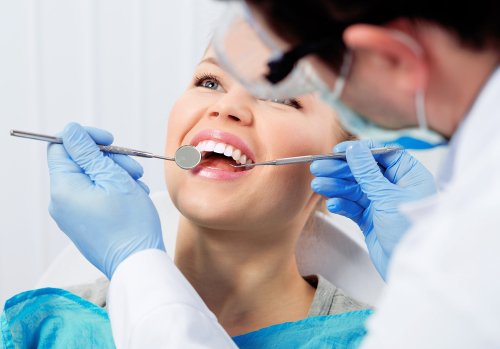Little Known Questions About Legacy Orthodontics.
Little Known Questions About Legacy Orthodontics.
Blog Article
The 45-Second Trick For Legacy Orthodontics
Table of ContentsLegacy Orthodontics - An OverviewA Biased View of Legacy OrthodonticsLegacy Orthodontics Can Be Fun For AnyoneGetting My Legacy Orthodontics To WorkThe Definitive Guide to Legacy Orthodontics
At Advanced Orthodontics, we supply patients with a alternative treatment experience. In addition, we offer flexible treatment schedules, versatile payment options and a fun, satisfying experience. orthodontist. Phone call ( 480) 357-4900 today to learn more and schedule a consultation.An orthodontist is a dental practitioner trained to diagnose, stop, and treat teeth and jaw irregularities. They deal with existing conditions and are educated to identify issues that may create in the future. Orthodontists deal with people of any ages, from youngsters to adults. Individuals typically associate a perfect smile with healthiness.
Malocclusion, or misaligned teeth, can cause oral concerns, including dental cavity, gum tissue illness, and hard or excruciating chewing. Not everybody is birthed with straight teeth. If you have a bad bite or huge rooms between your teeth, you might wish to get in touch with a dental practitioner focusing on orthodontic treatment.
The 8-Minute Rule for Legacy Orthodontics
( Photo Credit History: DigitalVision/Getty Images) Orthodontists utilize dealt with and detachable oral tools, like dental braces, retainers, and bands, to transform the setting of teeth in your mouth. Orthodontic therapy is for dental problems, including: Crooked teethBite issues, like an overbite or an underbiteCrowded teeth or teeth that are as well much apartJaw misalignmentThe goal of orthodontic therapy is to boost your bite.
A healthy and balanced bite ensures you can eat, eat, and talk appropriately. While you might assume of orthodontists as mostly for children or teens that need braces, they can fix dental issues at any age. Orthodontists attend college, dental school, and orthodontic college. After graduation, they invest 2 or 3 years in an orthodontic residency program.
All orthodontists are dentists, yet not all dental practitioners are orthodontists. Orthodontic residency programs offer extensive, concentrated direction for dental professionals. They concentrate on 2 areas: How to appropriately and securely move teeth How to properly lead growth in the teeth, jaw, and faceOnce an orthodontist has completed training, they have the alternative to end up being board licensed.
Our Legacy Orthodontics PDFs
Misalignment, or malocclusion, is the most common factor individuals see an orthodontist. It is hereditary and is the outcome of size distinctions between the upper and lower jaw or in between the jaw and teeth. Malocclusion results in tooth overcrowding, a twisted jaw, or uneven bite patterns. Malocclusion is usually treated with: Your orthodontist attaches steel, ceramic, or plastic square bonds to your teeth.
If you have only small malocclusion, you might have the ability to use clear braces, called aligners, rather than typical braces (https://www.metal-archives.com/users/legacyortho). Some individuals require a headgear to aid move teeth into line with pressure from outside the mouth. After braces or aligners, you'll need to put on a retainer. A retainer is a custom-made tool that keeps your teeth in location.
They're usually utilized on kids. They can produce additional area in the mouth without needing to pull teeth. If you have a major underbite or overbite, you could need orthognathic surgery (additionally called orthodontic surgical treatment) to extend or shorten your jaw. Orthodontists utilize wires, surgical screws, or plates to support your jaw bone.
You might require to see an orthodontist if you have: Crowding or not sufficient space for all of your teethOverbite, when your top teeth come your bottom teethUnderbite, when your bottom teeth are too far forwardSpacing or problems with gapsCrossbite, which is when your upper teeth fit behind your base teeth when your mouth is closedOpen bite or an upright void in between your front base and top teethMisplaced midline, when the facility of your base and upper teeth don't line up Dealing with an oral malocclusion can: Make attacking, eating, and talking easierImprove the proportion of our face and your total appearanceEase pain from temporomandibular joint disordersSeparate discover this your teeth and make them less complicated to cleanse, assisting protect against dental caries or dental caries It's often a dental practitioner that first notices misaligned teeth throughout a routine examination.
Legacy Orthodontics - An Overview

Throughout your initial orthodontic examination, you'll likely have: An oral examPhotos taken of your face and smileDental X-raysPanoramic (360 level) X-rays of your face and headImpressions to create mold and mildews of your teethThese examinations will assist your orthodontist understand how to continue with your treatment. leesburg clear braces. An orthodontist is a dentist that's had training to treat your teeth and jaw
An orthodontist is focused on your bite, so something like a chipped tooth would be handled by a dental practitioner. Orthodontists are focused on your bite, or the way your teeth fit with each other, and the straightness of your teeth.
Ever asked yourself just how stars constantly appear to have completely straightened teeth? The response frequently hinges on the experienced hands of an orthodontist. But what specifically does an orthodontist do? Orthodontists are dental specialists that concentrate on correcting irregularities in the teeth and jaws. Their expertise exceeds just creating a beautiful smile; it expands to improving your general dental health and feature.
The 25-Second Trick For Legacy Orthodontics

, orthodontists have a diverse toolkit at their disposal. These reliable dental braces utilize a system of brackets bonded to the teeth and connected by cords.
These removable trays are customized to gradually move the teeth's position. In instances of narrow jaws, palatal expanders can be made use of to produce area for appropriate tooth alignment.
Report this page